10 Best Italian Pizza – The History of Pizza
Are you looking for the best Italian pizza? It is no secret that this dish is the most loved food in the world, but can you imagine that only in Italy about 135 million pizzas are baked every month? Aside from being the most famous food in the world, it is also an Italian traditional dish and a symbol of sociality and sharing. For all of you who are wondering whether did pizza originate from Italy? The answer is yes. Pizza was invented in Italy, and we, who live in Italy, will share with you which is the best pizza in Italy that you should try! In this article, you can also learn about the history of pizza and discover its origins!
Secrets of the traditional Italian pizza
What does an original Italian pizza look like? Before we start talking about types of pizza and pizza history, we must clarify the basics! First of all, a traditional Italian pizza has a round shape, it’s made to order, and it’s baked in a wooden oven. As you will see below, there are plenty of regional varieties, but most of those on our list are from Naples, and they’ve got specific ingredients, that are not to be changed.
Beyond its shape, the pizza dough is key to the perfect pizza. The mistake we all make at home is, that we don’t leave the dough to leaven for enough time. In order to make the dough perfect, you need to leave the pizza to leaven for at least 24 hours! If it’s 48 hours, even better. That’s how we also teach our guests at Eatalian Cooks to make pizza. If it comes to the Neapolitan traditional pizza, leaven time is 72 or even 96 hours! If you ever wondered why your pizza dough isn’t as tasty as those in Italy, this is the answer. The time left for the dough to rest.
Then, the sauce! It’s no secret that in Italy even the pizza sauce tastes different. It’s not because the tomatoes would be so different (they actually are, if they are tomatoes from Sorrento for example). But, beyond the quality and taste of the tomatoes, there are two other important details! First, the tomato sauce is a fresh sauce made with fresh tomatoes, cooked actually. It’s cooked with other vegetables like celery, carrots, onion, and fresh spices like oregano and basil, etc. This is then blended together and used for the pizza. – Not canned tomato pure, and not anything else. Freshly made tomato sauce with real vegetables and fresh spices.
Two other secrets of traditional Italian pizza are the toppings and the heat of the oven. You must not use 10 different toppings, but instead, use 2-3 and make sure those are really high quality. This is key. And then, the heat of the oven is everything. Yes, you can bake pizza in your oven in the kitchen at 250 C degrees, but due to the time, it has to spend in the oven in order to properly bake ruins the toppings. You can even find great pizza ovens for your home that can actually go up to 400 C degrees, and this is the right heat for a pizza. Why? At this temperature, the pizza is ready in 2 minutes. The liquid of the sauce won’t evaporate, and it won’t look and taste dry.
Recommended Italian pizza recipe books
10 Best Pizza in Italy – Types of Italian Pizza
Planning your next trip to Italy? Can’t wait to taste your first real Neapolitan pizza? Do you know that there is a huge variety of variants to choose from? If you don’t want to get lost looking at the menu when sitting at a nice restaurant in Rome, Naples or Milan read this guide about the best pizza in Italy!
Moreover, you will learn that there are many variants that suit different tastes! Before we move into the article, we’d like to highlight, if you’re visiting Rome, that you can sign up for a pizza-making cooking class, the best local experience! After the 10 best pizza types, you’ll also find the history of pizza wrapped up in a few paragraphs! Make sure you scroll down to find out everything about the pizza history!
Before we get into our list and the history of pizza, you must also know that Neapolitan pizza is holding an STG Qualification since 2010 that was granted by the EU. This means that the original Neapolitan pizza is a guaranteed traditional specialty (specialita tradizionale garantita). This also means that the ingredients are controlled and regulated by law, just as the shape, the way the dough is prepared and cut, leavened, and where it can be consumed.
Now, what does it mean that they control where you consume it? It simply means that a real Neapolitan pizza MUST BE CONSUMED WHERE IT WAS BAKED. If you order it for takeaway, it’s losing the STG qualification. Now, to make it more understandable, the STG qualification is practically a guarantee for customers that they are being served the original dish, in an authentic way.
1. Margherita

The legend tells that in 1889 in Naples the Margherita was prepared with tomato, mozzarella, and fresh basil for Queen Margherita. She loved this creation so much that the pizza took her name. Behind legends, it is known, that Margherita did exist even before this, It just didn’t have the name that we know it to be today.
True lovers of the Margherita must try this Italian pizza in Naples Italy! This is the place where you could savor the best-tasting Margherita that’s made with local tomatoes, strictly with Fior di Latte mozzarella and fresh basil. Fior di Latte means literally the flower of milk.
We locals to make the Margherita even better, we pour a little extra virgin olive oil on top of it. To truly taste the best pizza in Italy though, it is really important that you try Margherita if you’re visiting Naples! We also cover for you some of the best restaurants for pizza in Naples, so if you’re there, you’ll know where to go!
2. Pizza Bufala

Pizza Bufala is a big favorite of many and it’s one of the best pizzas in Italy! The ingredients of Pizza Bufala are the same as the Margherita, with one core twist. Instead of the Fior di Latte cheese, they use Bufala cheese. This is also a type of mozzarella, but it’s made of water buffalo milk.
The other difference between the Margherita and the Bufala pizza is, that on the first one, the cheese is placed on top before it’s put in the wooden oven. On Bufala instead, the cheese is added on top freshly right after the pizza itself is baked. This makes this Italian pizza taste fresher and more refreshing. Bufala is another type of pizza in Italy that we recommend trying in Naples if you have the possibility!
3. Marinara
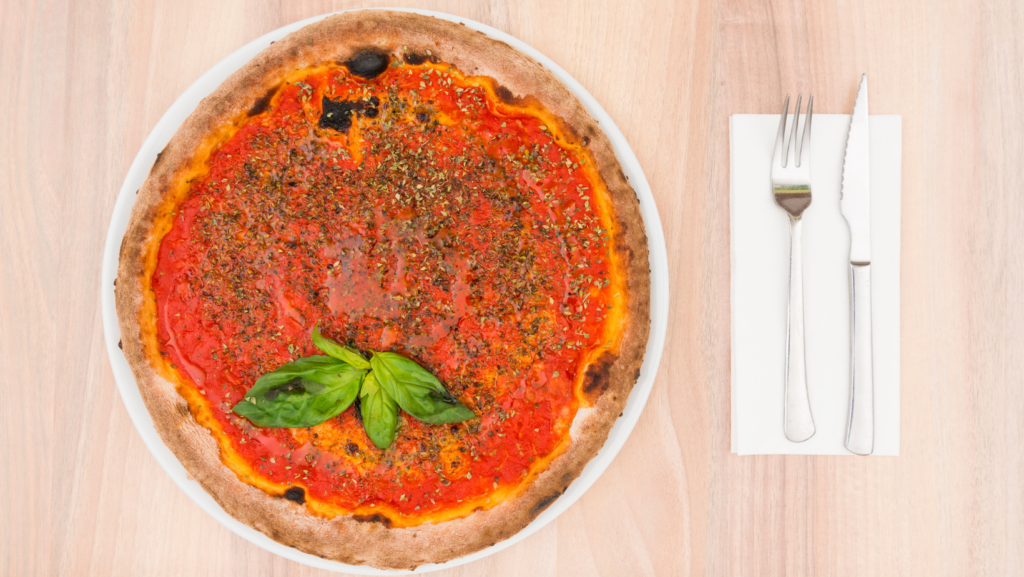
It’s proved that sometimes simplicity pays off! Marinara pizza is typical pizza in Naples, and it’s one of the best pizza in Italy you must try! Marinara is topped only with tomato sauce, garlic, oregano, and oil. This is probably the second most popular pizza after the Bufala.
The name marinara means “seafaring”, but there is no fish on this pizza! A fun fact about the Marinara is, that it’s the sailors’ perfect pizza, as it consists of ingredients that can be transported, and contained for a longer period (as there’s no cheese or meat on it). Sailors could bring the ingredients with them, and prepare a Marinara over longer journeys too. This is where the name “Marinara” actually comes from.
4. Pizza Capricciosa

Next up is a classy Italian pizza! Capricciosa is made with tomato, mozzarella, mushrooms, artichokes, capers, cooked or raw ham, and strictly black olives. This is one of my personal favorite pizza in Italy. Capricciosa is rich, delicious, and a big classic that I would pick every time possible, especially in Rome!
I highlighted Rome specifically because there they add an egg on top of the Capricciosa, which for some of you might sound weird, but believe me, an egg on the pizza is something really mindblowing! This changes the whole game of the taste of the pizza, and that’s why many of us love this Italian pizza the most!
Many of you who are not Italians are used to the overstuffed pizza, which has loads of ingredients of all sorts. And therefore, many of you might get really disappointed in Italy, when you order your first pizza, since here, we don’t stuff our pizza with a lot of toppings. If you don’t know which pizza to choose, you want something with more than 1-2 types of toppings, pick this one and you won’t be disappointed!
5. Quattro Stagioni
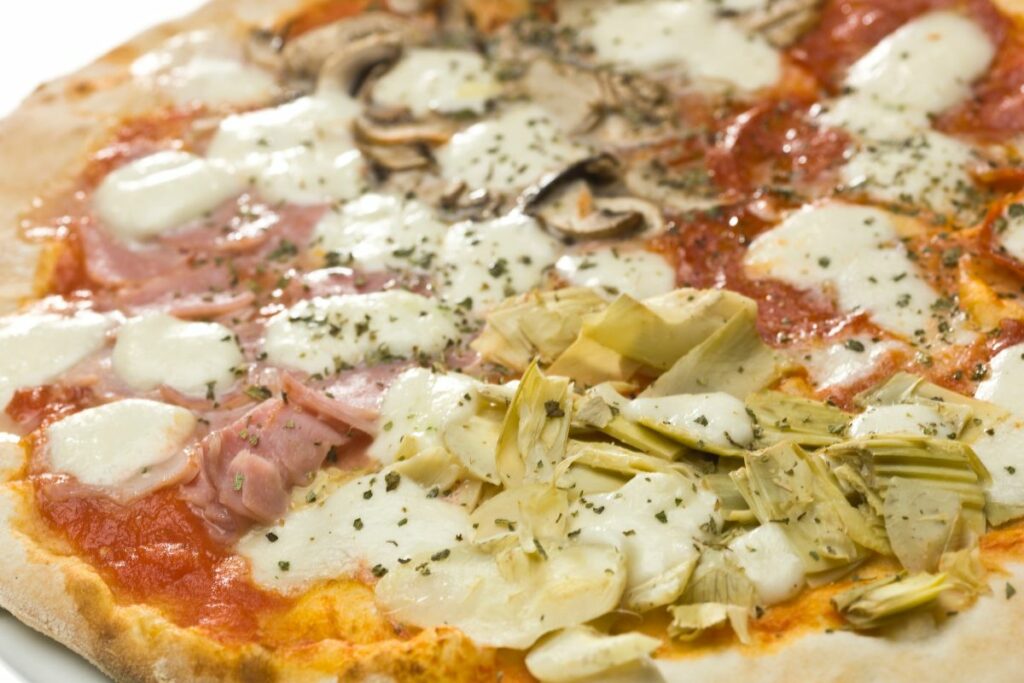
Presentation is important, they say! Well, then pizza Quattro Staggioni won’t let you down on this! To make this tasty pizza the ingredients are the same as on the Capricciosa, however, the pizzaiolo would divide the four ingredients into four parts of the pizza, and this would represent the four seasons.
Quattro staggioni means four seasons, so this is the explanation of the name. One quarter is topped with artichokes, one with mushrooms, one with ham, and the last one with black olives. If you’re looking for original Italian pizza, the Quattro Staggioni won’t let you down! Of course, underneath the toppings, this also has toppings tomato sauce, and Italian cheese, specifically mozzarella.
6. Pizza Diavola
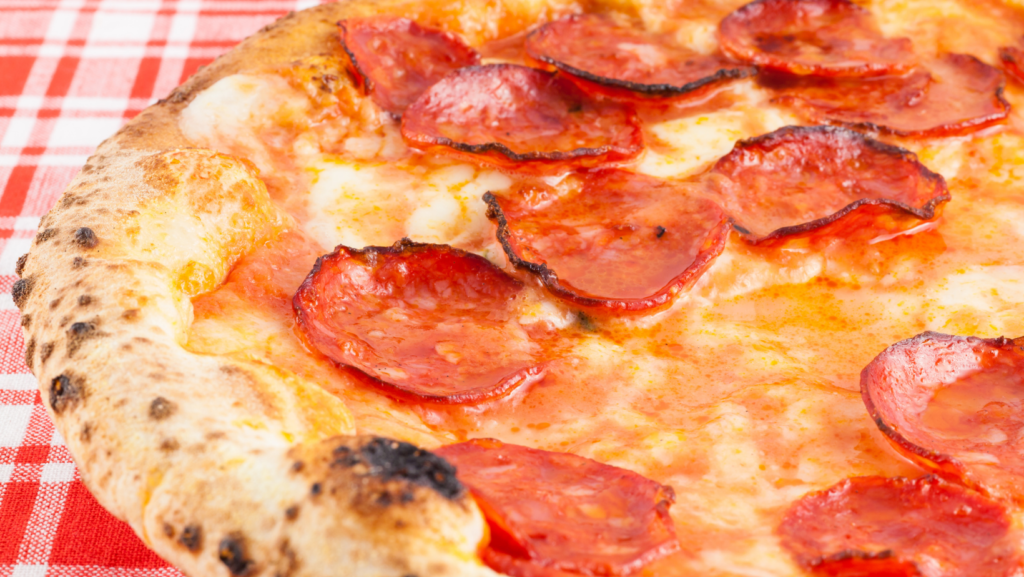
Another favorite of original Italian pizza is the Diavola. This, as well as all the previous ones can be found in literally every pizza restaurant in Italy. Diavola means literally Devil’s pizza, and it got this name due to the ingredients that are used to prepare it.
Now, the Diavola is prepared with tomato sauce, mozzarella, and spicy salami. Overall, it has a red color, as the salami is red too, and due to the spiciness and color combination, it acquired the name of being the devil’s pizza. This is one of the best types of pizza in Italy that you could order if you’re into spicy dishes!
You will also find in different parts of Italy some upgrades to the Diavola, such as gorgonzola cheese, onions, or even spicy pepper. Since in Italy, it’s tradition to make everything the traditional way, if there are other toppings on the Diavola than the traditional ones, you’ll most probably find it in the menu under another name.
7. Quattro Formaggi
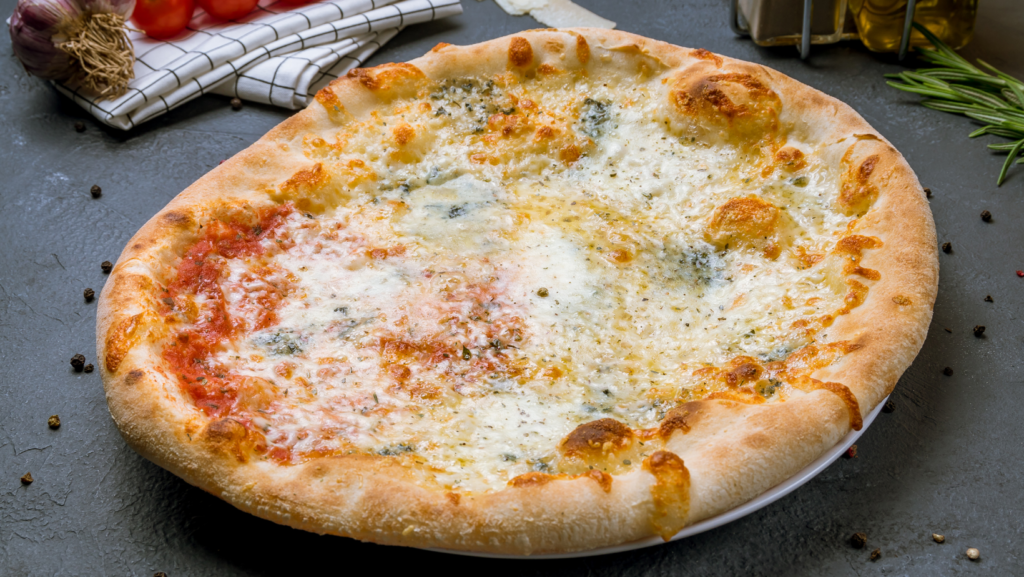
Quattro Formaggi is one of the most popular Italian pizza types that you could pick if you’re looking for a meatless, cheesy dish. This is truly one of the most delicious types of pizza in Italy, made with four types of cheese, hence the name. Among Neopolitan dishes, the Quattro Formaggi is made completely white. In other areas of Italy, you might find it with tomato sauce under the cheese.
Now, the four types of cheese are usually mozzarella, gorgonzola, fontina, and Parmigiano Reggiano. In some places, they might even add provolone cheese to it. Now, to make the Quattro Formaggi great, it’s important to use types of Italian cheese that are melting well. In this case, the fontina and gorgonzola are that make the topping so creamy.
8. Pizza Boscaiola
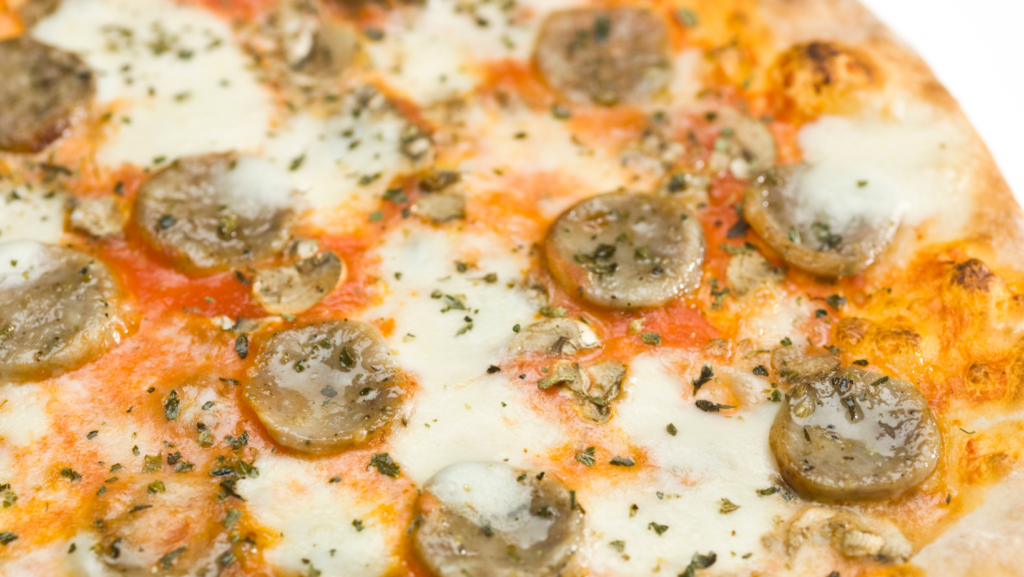
Mozzarella cheese, champignon mushrooms, and sausage are the elements of this typical pizza in Naples, the Boscaiola. Depending on your taste, you can choose whether to season it with tomatoes as well. You must know, that Boscaiola is most likely not available on other sides of Italy though!
Boscaiola is another traditional delight, that is considered also one of the best pizza in Italy. Of course, many of us rather go with ham and cheese, but for those who love sausage, this pizza from Italy will be right away a big favorite! In this picture, you can see sliced sausage, but usually, on Boscaiola you rather find sausage meat instead of proper sausage slices!
9. Carrettiera

Here’s another highlight of Italian pizza, the Carrettiera. It contains two typical ingredients of Neapolitan cuisine: sausage and broccoli. Add provolone or parmesan flakes to the top and it is a super tasty and delicious choice for the greedy ones! While it scares children still, broccoli is more and more popular all around Italy.
Besides the simple servings, people use around the world, in Italy broccoli is used for risotto and also pasta dishes with sausage. Now, since it appeared on pizza too, more and more get familiar and obsessed with types of pizza in Italy like the Carrettiera. One that you’ll also probably find only in Naples!
10. Pizza Napoli
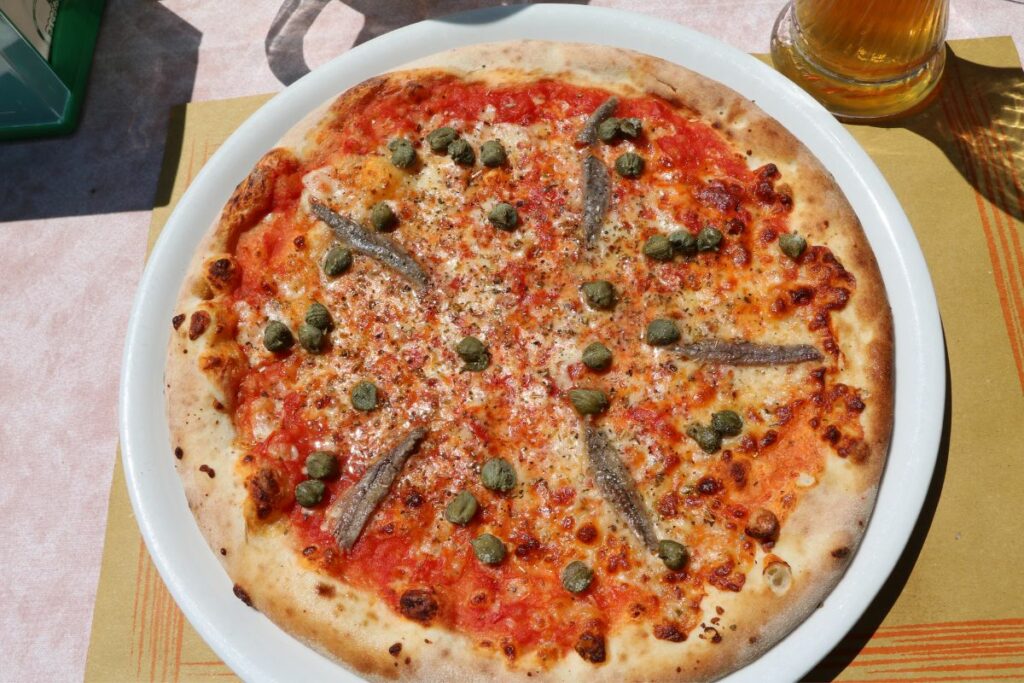
As we know, pizza originates from Naples. Now, based on that knowledge I’m here to show you the last but not least favorite, Pizza Napoli. As with most traditional, or original Italian pizza types, here too, simplicity is the key. You only need anchovy fillets, chopped garlic, and a generous sprinkling of fragrant oregano.
In Italy the traditional pizza, the calzone, and the pizzoli are the most popular, however, pizza scrolls are popular as well, especially for Aperitivo at home or served in bars. When you’re looking for local specialties, Napoli is one of those types of pizza in Italy, that will definitely not feel ‘boring’.
Is Pizza Italian? The history of Pizza
Now let’s see another aspect of Italian pizza, and let’s have a look inside the history of pizza in Italy if we already discussed some of the most famous traditional types. In the United States, there are usually two types of pizza you could find. The Chicago-style deep dish pizza, that’s thick and cheesy, or the more traditional New York pizza, which is thin. Just like in the US, in Italy too we’ve got two types of pizza dough traditionally. The Roman style, thin pizza, and the Neapolitan style pizza that’s thick on the sides only!
The history of pizza goes back thousands of years in the Mediterranean, as a seasoned flatbread made from flour and water. Of course today we use yeast to make it too. Back in history, the dough would be cooked by placing it on a hot stone and then seasoned with herbs. Greeks called the ancestor of pizza Plankuntos, and they used it as an edible plate for stews and thick broth soups.
This type of flatbread wasn’t like a pizza actually, but more like a Focaccia. These flatbreads though were consumed everywhere from Babylon to Egypt, from Rome to Greece. They were also mentioned and praised by historians of the time, Cato and Herodotos too. With this said, no, the ancestor of pizza, the seasoned flatbread is not originating from Italy, but let’s have a look into the actual pizza history too!
The origin of pizza
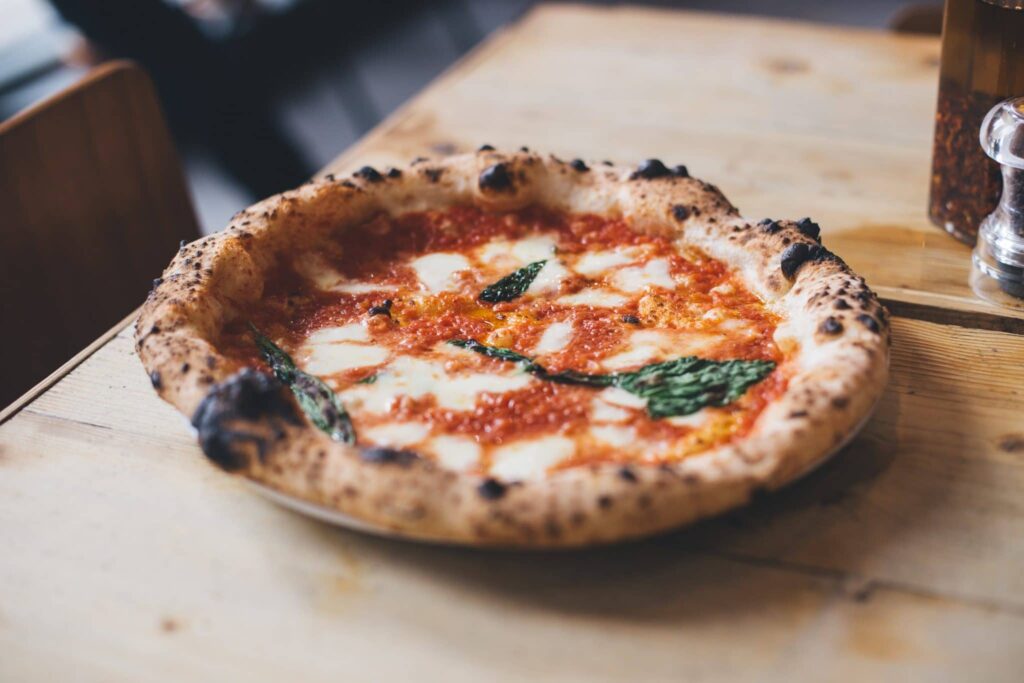
What do you need to know about the original Italian pizza? While speaking of the history of pizza, we must note the name pizza. Where does the name pizza come from? This word is originating from Latin, meaning pinsa, which means flatbread. The pizza history is not completely settled, as there’s one legend saying that the Roman army while stationed in Palestine, tried the Jewish Matzoth, and returning home they made a similar dish.
Archeological discoveries though found a preserved Bronze Age pizza in the region of Veneto. (I studied history at university, and honestly, there are many “finds” that I don’t give credit to, due to my personal knowledge of archeology, and this pizza from Veneto is one of them. I’m wondering how a pizza could be preserved for over 2500 years). Anyway, the origins can’t be confirmed at 100%.
In the Middle Ages though, people in Italy would make pizza dough, topping it with olive oil and herbs, which is again something that we know as Focaccia. Later, with the introduction of the Indian Water Buffalo, the pizza gained another meaning after they started making mozzarella cheese. Up until today as you could see, most traditional Italian types of pizza are made with fresh mozzarella. Not a dried, shredded version that you’d see in other countries.
Tomatoes were introduced to Italian cuisine in the 18th and early 19th centuries, which contributed to the creation of today’s known Italian pizza. While tomatoes arrived first in Italy in the 16th century, many didn’t use them as they thought it’s poisonous, and they grew them only for decoration. This then changed when in Naples they started using tomatoes for their dishes, as at the time, Naples was very poor, and people were starving. This is why also the flatbread got later tomato sauce on top after Neapolitans discovered how the tomato is not poisonous at all.
As the popularity of modern pizza started to increase in Naples, in the beginning, people would sell it on the street for every meal. Then, they started founding shops/bakeries where one could order custom-made pizza with different toppings. By 1830, Antica Pizzeria Prto’Alba in Naples has become the first ever pizza place, a true pizzeria, and they still function by the way!
New Trends in Pizza and types of flatbread in Italy
Beyond the traditional Italian pizza, as the history of pizza in Italy states, there were and are different types of flatbread. The most important is the Focaccia, which is also different in different parts of the country. Normally, the traditional Ligurian focaccia is a thicker flatbread, topped with olive oil and rosemary. Before you bake it, you must go through the extended dough and make holes in it using your fingers. This allows the bread to cook properly and create those fluffy parts in between the holes you created.
Focaccia in Rome though it’s much thinner than the traditional one. And the toppings are also changing from one region to another. Then, other types of flatbread and pizza and the Sfincione, which is a thick Sicilian sheet-like pizza. This has for topping tomato sauce, anchovies, breadcrumbs, and Caciocavallo cheese. There’s also the popular closed pizza, the Calzone, and the Pizza al Taglio, which is very popular, especially in Rome.
FAQ: Italian Pizza – History of Pizza
The history of pizza dates back to the Egyptians, Greeks, and Romans, while they were all consuming flatbread with different toppings. Today’s pizza was born in southern Italy, in the region of Campania, Naples.
Pizza in Italy is served without being sliced before serving. We in Italy slice it yourself, and fold in two the slices, because it’s usually very thin, and eat it with our hands. On side of the pizza, Italians always order a beer.
YES! There are certain toppings that Italian consider to be exaggerated, and pineapple is definitely one of these toppings. There are so many delicious fresh toppings you can add to a pizza. This isn’t a dish that’s supposed to taste sweet!
You pronounce pizza just as you say it in English. The only thing that’s changing is that the ZZ sounds more like a long C (from Circus), like you’d be saying picca. – I believe it’s more accurate saying that it’s a sound between the Z and the C from circus.
Italian pizza is made with fresh ingredients, more importantly, high-quality ingredients. The sauce is prepared with different vegetables cooked together with the tomatoes. It’s never JUST a simple tomato puree with some oregano. Then, every topping used is fresh, and of great quality, and we never put too much topping on our pizza. Quality is more important than quantity.
The reason is simple. There are some tricks that Italians always respect when it comes to pizza. For example, the time they leave the dough aside (usually 24, 48 hours), the quality of ingredients, and that in Italy, we make food with so much love. Food is not for just stuffing our bodies, it’s for JOY!
Wrapping up the best Italian pizza – The History of Pizza
In conclusion, we can easily state one of the most important food facts about Italy is that pizza is loved by everyone, inside the country and outside. Most importantly, before learning how is pizza made in Italy you should definitely try it and choose which is your favorite one! Defining which is the best pizza in Milan Italy or the best pizza in Rome can be tricky. It is also a matter of taste!
For instance, the best pizza in Naples Italy can be either Margarita if you like tradition, Capricciosa if you crave appetizing food, or maybe a Marinara if you prefer simplicity. In addition, Pizza Quattro Formaggi, in its traditional version when you don’t feel like eating tomato or pizza Diavola for spicy lovers.
Italian version: Migliore pizze Italiane
Hungarian article: Olasz pizzák
Pin it: 10 best Pizza in Italy – The History of Pizza




3 thoughts on “10 Best Italian Pizza – The History of Pizza”
Comments are closed.


Are the Italian pizza the best one ? Everyone is saying this, is it a myth or a reality?
Pizza quattro formaggi, the classical 😍
I can’t wait to go in Italy and to try all their specialty 😭